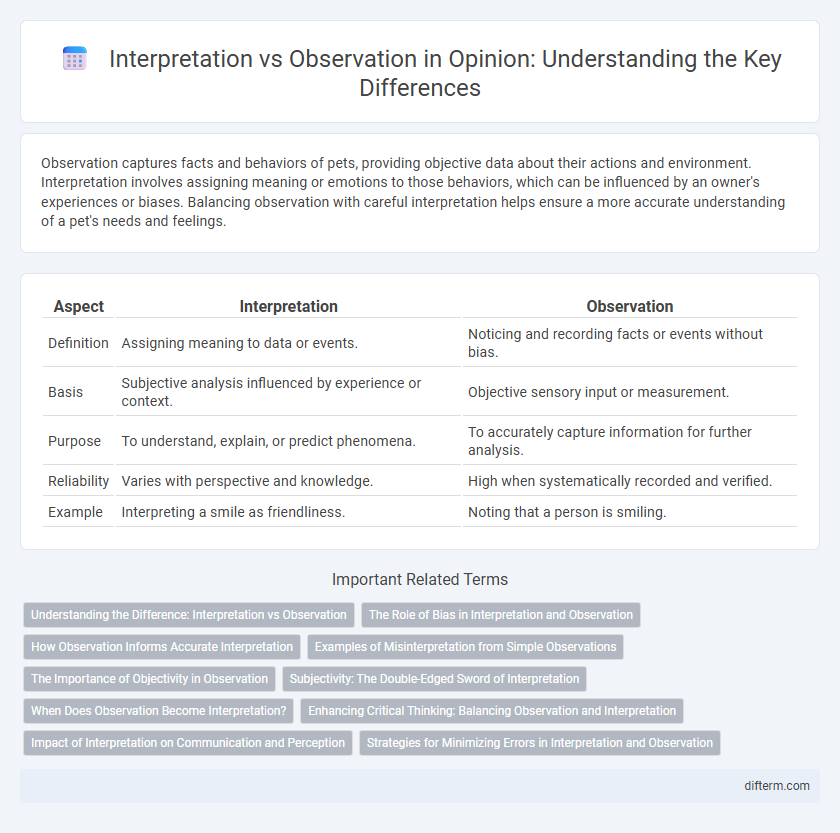Observation captures facts and behaviors of pets, providing objective data about their actions and environment. Interpretation involves assigning meaning or emotions to those behaviors, which can be influenced by an owner's experiences or biases. Balancing observation with careful interpretation helps ensure a more accurate understanding of a pet's needs and feelings.
Table of Comparison
| Aspect | Interpretation | Observation |
|---|---|---|
| Definition | Assigning meaning to data or events. | Noticing and recording facts or events without bias. |
| Basis | Subjective analysis influenced by experience or context. | Objective sensory input or measurement. |
| Purpose | To understand, explain, or predict phenomena. | To accurately capture information for further analysis. |
| Reliability | Varies with perspective and knowledge. | High when systematically recorded and verified. |
| Example | Interpreting a smile as friendliness. | Noting that a person is smiling. |
Understanding the Difference: Interpretation vs Observation
Interpretation involves assigning meaning or significance to sensory input, often influenced by personal experiences and biases. Observation refers to the objective act of noticing and recording facts without inferring meaning or conclusions. Distinguishing between interpretation and observation is crucial for accurate analysis and effective communication in both scientific research and everyday decision-making.
The Role of Bias in Interpretation and Observation
Bias significantly influences interpretation by shaping how information is filtered and understood, often leading to subjective conclusions that diverge from objective reality. Observation aims to capture facts neutrally, yet it can also be compromised by selective attention and preconceived notions. Recognizing and mitigating bias is essential to improving the accuracy and reliability of both observation and interpretation processes.
How Observation Informs Accurate Interpretation
Observation provides concrete data that grounds interpretation in reality, ensuring conclusions are based on actual evidence rather than assumptions. Accurate interpretation depends on careful attention to observed details, patterns, and contexts, which guide meaningful understanding. This process minimizes bias by rooting insights in objective, verifiable information.
Examples of Misinterpretation from Simple Observations
Observing a smile can be misinterpreted as happiness when it might mask discomfort or anxiety, illustrating how surface-level observations often lead to incorrect conclusions. For example, seeing someone avoid eye contact during a conversation might be mistakenly taken as dishonesty, despite cultural differences or shyness being the true reasons. Misinterpretations like these highlight the necessity of cautious analysis beyond initial observations to avoid biased opinions.
The Importance of Objectivity in Observation
Objective observation serves as the foundation for accurate knowledge by eliminating personal biases and ensuring that data reflects reality rather than interpretation. Maintaining strict objectivity allows observers to gather reliable evidence that can be analyzed without distortion, preserving the integrity of the findings. This separation between observation and interpretation is crucial in scientific research, journalism, and decision-making processes where factual accuracy is paramount.
Subjectivity: The Double-Edged Sword of Interpretation
Interpretation introduces subjectivity by coloring facts with personal biases, making it a double-edged sword that both enriches and distorts understanding. Observations, grounded in objective data, serve as anchors, yet their meanings shift through the lens of interpretation. This interplay challenges the pursuit of truth, highlighting the tension between raw data and human perception.
When Does Observation Become Interpretation?
Observation becomes interpretation when sensory data is filtered through personal experiences, biases, and assumptions, altering the pure collection of facts into subjective meaning. This transformation occurs as the observer assigns value or context, making the initial observation less about objective reality and more about individual perception. Understanding the subtle boundary between observing and interpreting is crucial for accurate knowledge and critical thinking.
Enhancing Critical Thinking: Balancing Observation and Interpretation
Balancing observation and interpretation sharpens critical thinking by ensuring that raw data is accurately perceived before meaning is assigned, reducing bias and enhancing clarity. Observation provides objective evidence, while interpretation contextualizes and derives significance, creating a dynamic interplay essential for informed analysis. Developing this balance strengthens analytical skills and promotes well-rounded decision-making in complex scenarios.
Impact of Interpretation on Communication and Perception
Interpretation shapes communication by filtering raw observations through individual biases, cultural backgrounds, and prior knowledge, often altering the intended message. This subjective process influences perception by constructing meaning that may differ significantly from the original facts. The impact is evident in misunderstandings, enhanced empathy, and varying realities shaped by personal or collective interpretations.
Strategies for Minimizing Errors in Interpretation and Observation
Minimizing errors in interpretation and observation requires systematic strategies such as employing standardized data collection methods and cross-validating findings with multiple sources. Implementing training programs to enhance observer awareness reduces cognitive biases and improves accuracy. Utilizing technological tools like digital recorders or software for data analysis further strengthens the reliability of observational and interpretative processes.
interpretation vs observation Infographic

 difterm.com
difterm.com